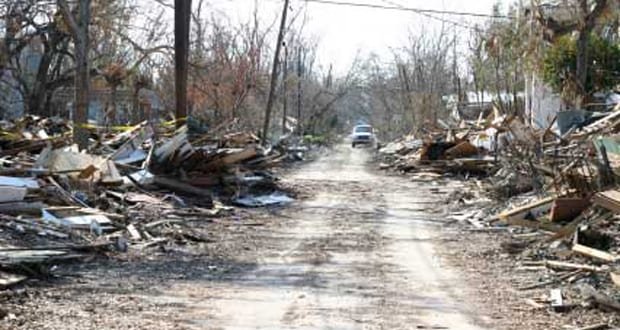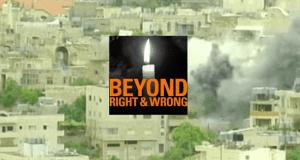Marc Giudici, PhD, NCC
Adjunct Faculty, Massachusetts School of Professional Psychology
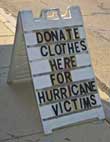 ABSTRACT:
ABSTRACT:
Media coverage of Hurricane Katrina raises questions about accurate representation and the resultant costs in human suffering. This article elucidates some of the documented facts related to Hurricane Katrina, its comparison to 9/11, and clarifies misconceptions of the initial relief effort and impact on those impacted by the Hurricane.
I question the media’s approach to New Orleans in the aftermath of Hurricane Katrina, to the exclusion of other affected areas, and examine the effect this had on the Mississippi Gulf Coast’s recovery and rebuilding effort. As a mental health professional and building contractor, I was on the Mississippi Gulf Coast for one year after the storm and was heavily involved in the recovery effort. I was witness to the efforts made by communities and volunteers from all over the world, as well as the efforts from the federal and local governments. This article is intended to bring to light the well-documented history surrounding the regions most directly affected by the events of August 29, 2005.
- Citation
- Author
 Marc Giudici, PhD, NCC is a Nationally Certified Counselor with roots in the San Francisco Bay Area and Mississippi Gulf Coast. Giudici earned his Master in Counseling Psychology Degree at the University of Mississippi and has recently earned his Masters in Media Psychology Degree through Fielding University.
Marc Giudici, PhD, NCC is a Nationally Certified Counselor with roots in the San Francisco Bay Area and Mississippi Gulf Coast. Giudici earned his Master in Counseling Psychology Degree at the University of Mississippi and has recently earned his Masters in Media Psychology Degree through Fielding University.
Since Katrina, Giudici’s passion, time, and research have been focused on the Hurricane Katrina survivors and relief effort. He spent the initial year post-storm on the Gulf Coast working with the Survivors of Katrina providing mental health services and assisting the long term planning and recovery process. Marc is fueled, inspired, and humbled by the resilience, post-trauma growth, and forward thinking of people along the Mississippi Gulf Coast.
As a result of his experience with Katrina survivors, Giudici is in the final stage of developing in an assessment tool that mines for strengths and assets of those that have experienced trauma to be used in the future to assist with post-recovery efforts. In addition, Giudici is committed to promoting the evolving field of Media Psychology and its role in psychology. He has been invited to speak at the Mississippi Conference on Attention Deficit Hyperactivity Disorder, as guest lecturer providing Media Psychology rich information and interventions for those that are working with this difficult population. Giudici’s previous research focused on developing medication compliance profiles using selected scales from the MMPI-2 with the Veteran population. He continues to work in this area. Contact: marc@marcgiudici.com
Introduction
Hurricane Katrina was the deadliest hurricane to hit the United States in over seven decades (Kessler, Galea, Jones, & Parker, 2006). This natural disaster is often compared and contrasted to the relief effort of the 9/11 terrorist attacks. Both were mentally, emotionally, and fiscally devastating to the United States. Many have said that the efforts for 9/11 were more decisive, organized, and expedient than the effort for the Gulf Coast. In many circles, the issue of race as been mentioned, with many believing that if this storm had occurred in a more affluent area, resources and relief would have been more expedient and plentiful than it was to the Mississippi Gulf Coast (Davis & Land, 2006).
In reality, the response from FEMA and other Federal groups was pursued in a timely manner, but given the vastness of the territory to be supported, the effort may not have been as consolidated as NYC’s need to respond to 9/11. It is important to note the scope and breadth of the Hurricane Katrina disaster when comparing it to the relief effort of 9/11. The 9/11 attack encapsulated a 16 acre area encompassing roughly 12 city blocks (McAllister, Barnett, Gross, Hamberger & Magnusson, 2002). Conversely, Hurricane Katrina and its devastation spanned over 90,000 square miles, roughly the landmass of the United Kingdom (Kessler, Galea, Jones, Parker, 2006). The size of the effected area reflected a disaster like no other in our country’s history and the magnitude of the immediate needs were tremendous.
A significant amount of the initial post storm suport was provided by a myriad of groups and faith-based organizations during the first few months of the initial relief. These groups brought much needed supplies and services to the devastated areas that were without power, land telephone lines, water, or sewer and was compounded by the intense and relentless heat that was inescapable. Without these selfless responders offering assistance to the local communities, the initial effort would have not been as successful as it was. Efforts like these were also evident with the relief work of the 9/11 tragedy, however, the immensity of the Gulf Coast destruction did not allow for an emotional or physical retreat to rest and recoup from the relief effort. There were no neighbor’s homes or local sites to go for a shower, to rest, and regain perspective. In fact, as a measure to preserve those that were volunteering on the Mississippi Gulf Coast, many of the relief workers were brought in on a two-week rotation then cycled out to allow some time away from the calamity, heat, septic smells, and disease while providing time to heal and recover. These are the majority of the voices that are heard in the media chronicling the recovery effort. Unfortunately those who where relegated to stay and those who resided on the Gulf Coast did not have that luxury of that voice. Families forced to live in shelters entered and exited through heavily military armed doors and used their cots as boarders to cordon space that they could call their own. Many of the shelters were converted community centers or gymnasiums filled to capacity with cots, packed with people of various different social classes, and crowded with all of their remaining possessions. In most of the shelters, there were rigid lights out policies requiring lights be turned off at 10:00 pm and on at 6:00 am. Although this may have helped to promote some normalcy with school age children allowing them to get up for school, it posed a difficult timeline for those families with infants or other special needs. Parents attempted to sleep during the day with their infants in a room with many other families, most of whom were awake and active during the day (Gleason, 2005). Many of the parents were devastated with their own loss and exhaustion and had little emotional support for their own children (Gleason, 2005). 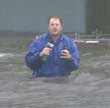
A quick snapshot from the media reports initially portrayed Survivors of Hurricane Katrina as a fiscally irresponsible, uneducated population. On the contrary, most families on the Gulf Coast were fiscally smart, hardworking, assiduous people. These families made enough money each month to pay their bills, send their children to school, secure medical and home insurance, and live modest but comfortable lives. Family homes were handed down from generation to generation so there was no debt service attached to them, keeping their overhead quite low. Prior to the storm, the modest living was enough to sustain their family. They were living in a state of what I call ‘Highly Functioning Poverty (HFP),’ functioning but on a budget that did not allow for flexibility or emergencies. After the storm hit, their tightly structured budget could not tolerate any inconsistencies, especially one of this magnitude. Their family homes were destroyed, belongings lodged in trees, cars flooded in their yard, along with foliage and debris everywhere. There was no excess or reserve funds to finance any clean up or rebuilding work. Insurance companies denied most families restitution because their damage was “flood related” although their home were not located in flood zone that required additional flood insurance. It was nearly impossible to ascertain what actually caused the damage to the homes: wind or flood since, in many cases, no home remained. For these families, their only source of shelter and equity was lost. A few did receive some money from FEMA or the State, however, the new flood planes were re-zoned and federal regulation even mandated new building standards making it no longer feasible to rebuild. Now, these families were no longer HFP, they were homeless, impoverished, and with little foreseeable hope. Contrary to some reports, many were hard working people that did not have enough reserve capital to absorb the total loss of their home and all of its contents,
Figure 1. Path of Hurricane Katrina showing the epicenter of Hurricane Katrina.
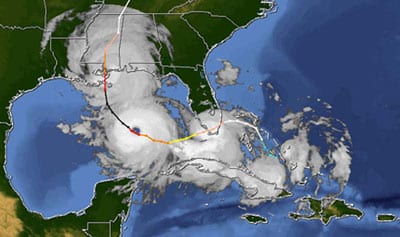
By the time that Hurricane Katrina made landfall in New Orleans on August 29, the storms force had reduced from what was predicted to be a category 5, the most cataclysmic level of a hurricane, to a category 3 (Grunwald, 2007). The general feeling that emulated from the initial assessment of the damages to New Orleans was that the storm could have been much worse (Brinkley, 2006). There was a wide feeling of relief that the city was once again spared doom from the hurricane that would be the demise of the city (McClay, 2007). Harrison and Hancock counties in Mississippi, the epicenter of Hurricane Katrina, were not so fortunate. Where New Orleans was spared from the natural disaster of Hurricane Katrina, Mississippi Gulf Coast towns like Pass Christian, Bay St. Louis, Waveland and the eastern parts of Biloxi, were annihilated. It was as if a large rake had come through the area and pulled these small Gulf Coast towns into the Gulf of Mexico, leaving behind only slab foundations or, in many cases absolutely nothing.
In contrast, had it not been for the breaches in three different levees after Hurricane Katrina had passed, the city of New Orleans would have likely experienced only minimal flooding and wind damages (McClay, 2007). “The most important thing to remember about the drowning of New Orleans is that is was not a natural disaster. It was a man-made disaster, created by lousy engineering, misplaced priorities and pork-barrel politics” (Grunwald, 2007).
Path of Katrina
A brief review of history illustrates that the levees that surround New Orleans have had a long history of difficulties. The first concerns regarding the waters that surround New Orleans were in 1719 by Sieur de Bienville, one of the earliest Europeans to develop New Orleans. But in his opinion, this area was an ideal natural port for commerce that would allow straightforward shipping access to the adjoining rivers. The proclivity for the area to flood did concern him, so he began what were the first levees and went forward laying out the first roads in the new city (Brinkley, 2006). Unfortunately, in 1722, a hurricane did hit New Orleans carrying with it a ten-foot storm surge, flooding the area. At that early stage of subsistence, the new city for all practical purposes ceased to exist. Fueled by economic motivations, however, Bienville went forward with his plan for a great port city and began the task of rebuilding the inundated city. Motivated by the idea that there was money to be made in the region, the Unites States government continued to go forward with Bienville’s plan to expand the area. In an attempt to secure the area, given the knowledge for the regions’ propensity to flood, they began the construction of miles of levees. Unfortunately, the city’s history repeated itself several more times despite these efforts. In 1849, the city flooded burying over 200 city blocks. Again, in 1893 the city experience another similar disaster killing more than two thousand New Orleanian citizens, and in 1909 again the city was ravaged. In 1927, in an attempt to ease the flooding to the city, the levees were detonated allowing the water to cascade in the poorer predominantly black neighborhoods to “protect the rest of the area” (Brinkley, 2006). The event resulted in an eroded confidence in the levee boards by the African American population in New Orleans who believed that if the white gentry did it once, they would do it again (Brinkley, 2006).
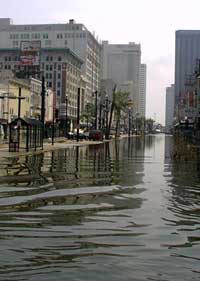 Since the epicenter of Hurricane Katrina landed East of New Orleans in the Hancock and Harrison Counties of Mississippi, there was a significantly reduced intensity of the storm experienced by New Orleans (Grunwald, 2007). It was the breach in three different levees after Hurricane Katrina had passed which transformed Hurricane Katrina from a deadly and tragic hurricane for the people of Mississippi to the most costly disaster in American history (McClay, 2006). The failure of the 17th Street and London Avenue drainage canals causing the rupture that led to the flooding of much of the city appears to have occurred because the peaty soil beneath the levee walls had become saturated. While, it was commonly felt that if the walls had just been built higher, the levees would have held, this discovery invalidates that belief.
Since the epicenter of Hurricane Katrina landed East of New Orleans in the Hancock and Harrison Counties of Mississippi, there was a significantly reduced intensity of the storm experienced by New Orleans (Grunwald, 2007). It was the breach in three different levees after Hurricane Katrina had passed which transformed Hurricane Katrina from a deadly and tragic hurricane for the people of Mississippi to the most costly disaster in American history (McClay, 2006). The failure of the 17th Street and London Avenue drainage canals causing the rupture that led to the flooding of much of the city appears to have occurred because the peaty soil beneath the levee walls had become saturated. While, it was commonly felt that if the walls had just been built higher, the levees would have held, this discovery invalidates that belief.
The failure of the Industrial Canal, which flooded the Ninth Ward, appears to be in part exacerbated by the surge of water directed up the Mississippi River Gulf Outlet. The Mississippi River Gulf Outlet (MRGO) is a man made navigational channel that was originally designed and developed primarily for economic reasons. The MRGO was touted as a great industrial development, offering a 40-mile shorter route through St. Bernard Parish circumventing the twisted and time consuming Mississippi River expediting the route from the Gulf of Mexico to the City of New Orleans (Gunn, 1997). The fabrication of the MRGO is responsible for wetland deterioration and loss. The resultant erosion of the marshes that served as a buffer against hurricanes led to an increased flood risk. In addition, the location of the MRGO makes it a the “superhighway for storm surge” (Kerlin, 1979), unable to contain the rising water levels generated by hurricane-force storm winds pushing the water sources back toward land. An underutilized and immensely expensive navigational shortcut, the waterway diversion and channeling limitations of the Outlet were well documented in 1965 by engineers at completion (McClay, 2005). All three of these projects were the developed and built many decades ago by the Army Corps of Engineers all funded by the federal government. The history of the New Orleans levee system highlights the fact that, in spite of funding by federal government, ill planning and inadequate construction were the source of the levee failures. New Orleans, which lies mostly below sea level surrounded by large unpredictable bodies of water, is and will continue to be, a challenge to protect.
Based on the documented history of New Orleans, there appears to be a truth to Grunwald’s assertion that the drowning of New Orleans was a man-made disaster. If the flooding and devastation to New Orleans can be attributed to mismanagement of resources and faulty design of the levees by the Army Corp of Engineers, and not the natural forces generated by Hurricane Katrina, how did the media come to promote and publicly denounce Hurricane Katrina as the culprit for the devastation to New Orleans? Journalists are bound to the Society of Professional Journalists’ (SPJ) Code of Ethics that states, “Professional integrity is the cornerstone of a journalist’s credibility” (Society of Professional Journalists, 2002). Furthermore, the code establishes that journalists shall:
- Distinguish between advocacy and news reporting
- Be free of obligation to any interest other than the public’s right to know
- Avoid conflicts of interest, real or perceived
- Remain free of associations and activities that may compromise integrity or damage credibility.
Perhaps the foundation of the SPJ code of ethics reminds journalists to minimize harm and that quality ethical journalists treat sources, subjects and colleagues as human beings deserving of respect (Brown, 2006). Is it ethical to direct public attention to the devastation of one area to the exclusion of others and to attribute the New Orleans failure to Hurricane Katrina rather than compounded by historical human incompetence? The media focused so singularly on New Orleans, that much-needed attention was diverted from the plight of the Mississippi Gulf Coast.
In a search of peer reviewed articles, over 3,755 articles were written about Hurricane Katrina and New Orleans. The number of articles written about the Mississippi Gulf Coast as a result of Hurricane Katrina were limited; Pass Christian, MS had 17, Bay St Louis MS had 9, and Waveland generated 15. Yet all of these cities were annihilated by the natural disaster of Hurricane Katrina and her tidal surges. In the surrounding cities such as Long Beach, Gulfport, and Biloxi, MS, articles were scarcely written 14, 61 and 98 respectively. In a broad search of news articles using the search engine Google, the numbers of articles published across various news outlets were also greatly imbalanced. A search of articles on Katrina and New Orleans returned 7,930,000 articles, Pass Christian had 78,000, Bay St Louis 66,400, Waveland 18,600, Long Beach 127,000, Gulfport 156,00, and Biloxi had 239,000 articles posted. Due to the immense media coverage, misrepresentation, and public unawareness of the actual events created by the natural disaster Hurricane Katrina, the name “Katrina” has become a synonym used by the media and the Government to gain public sympathy for those that are affected by the mismanagement and improprieties of the federal government. An example is a statement made by Chairman of the Senate Banking Committee, Senator Christopher Dodd, who referred to the regarding the current real estate market as a “crisis [that] is the equivalent of a slow-motion, fifty-state Katrina, taking people’s homes one-by-one, devastating their lives and destroying their communities.”
As media psychologists, we must ask if it is ethical to direct public attention and promote the New Orleans disaster to Hurricane Katrina at the expense of the Mississippi Gulf Coast? This instance of inaccurate reporting, regardless of intentions, has massaged and molded the public’s awareness of Hurricane Katrina to be synonymous with the recovery effort of New Orleans and diverted attention and resources away from the plight and recovery efforts of thousands in the Mississippi Gulf Coast. Now it is almost impossible to disentangle the natural event of Hurricane Katrina from the man-made disasters caused by the broken levees, raised racial tensions, and political mistrust. On August 29, 2005, by what some call an “act of God,” Hurricane Karina with her 35-mile-wide eye hit the Mississippi Gulf Coast with fierce winds exceeding 230 miles per hour and pushing a massive 35 foot title surges ashore (Thompson, 2005). The storm damaged or destroyed more than 242,000 homes, 4,800 businesses, and killed 217 people in Mississippi, almost totally leveling Harrison and Hancock counties (Louisiana Association of Nonprofit Organizations, 2007).
Immediately in the post-storm aftermath, the catastrophe was at the center of the media spot light showing picture of piles of debris, slabs of concrete that were once the foundations of antebellum homes, staircases leading to nowhere, personal possessions strewn chaotically throughout trees and along the coastline, broken and fragmented roads in some parts completely washed away, personal suffering, and the absence of life in these now non existent cities. The focus of media attention prompted nonprofit organizations to spring into action, and sparked a nationwide fundraising effort that brought in millions of dollars. The first responders in the initial recovery effort were from all walks of life. Faith-based groups, individual citizens, college students, Mennonites, Amish, and rock stars all were there to assist with food, water, clean up. Now, as the two-year anniversary approaches, some of those same organizations are ramping up their communications efforts to explain their roles during a crisis and to educate the media and Americans about issues still facing the Gulf Coast and its residents (Iacono, E. 2007). Shelley Borysiewicz, manager of media relations at Catholic Charities USA, states that “the Catholic Charities’ mission for disaster response is long-term recovery, so our work is just getting started… The message we want to get out to media, donors, and the general public is that despite (the fact) that it’s two years later, there’s so much work left to be done.” The federal government estimates that the recovery on the Mississippi Gulf Coast could take as long as fourteen years. Still, many are without homes and struggling to get through the day.
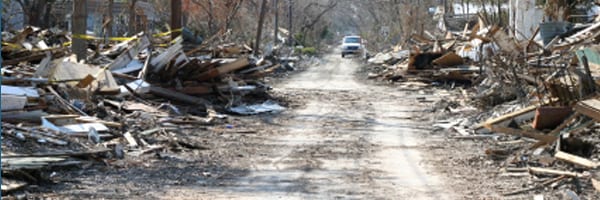 The media’s failure to maintain professional standards of integrity through thorough discovery, accurate reporting, and clarity in understanding, has actually harmed the Gulf Coast Communities. As reporting of the Mississippi Gulf Coast faded, the focus continues to dwell on New Orleans and with it the volunteers and resources that the people of Mississippi Gulf Coast so badly need in their recovery process. As seen in the ESCBO and Google article search, it is now a common misconception that Hurricane Katrina devastated exclusively New Orleans. With this mindset and attention toward New Orleans, the direction of relief dollars, resources, and personal assistance are diverted away from the Mississippi Gulf Coast. Currently, the most affected cities in Mississippi are still lacking the redevelopment and construction of the basic infrastructure such as power, phone, and sewer that is necessary to be established before any of the family’s who were forced away from these cities home can even consider returning.
The media’s failure to maintain professional standards of integrity through thorough discovery, accurate reporting, and clarity in understanding, has actually harmed the Gulf Coast Communities. As reporting of the Mississippi Gulf Coast faded, the focus continues to dwell on New Orleans and with it the volunteers and resources that the people of Mississippi Gulf Coast so badly need in their recovery process. As seen in the ESCBO and Google article search, it is now a common misconception that Hurricane Katrina devastated exclusively New Orleans. With this mindset and attention toward New Orleans, the direction of relief dollars, resources, and personal assistance are diverted away from the Mississippi Gulf Coast. Currently, the most affected cities in Mississippi are still lacking the redevelopment and construction of the basic infrastructure such as power, phone, and sewer that is necessary to be established before any of the family’s who were forced away from these cities home can even consider returning.
Given the initial outpouring of support provided to the Mississippi Gulf Coast immediately post storm while the media was in attendance and the level of continued support being directed toward New Orleans even today, I believe that if the media had continued to report the effects of Hurricane Katrina (the natural disaster) on the Gulf Coast, their current recovery process would be much farther along. It is the ethical responsibility of the media to ensure the accurate portrayal and reporting of the events such as Hurricane Katrina. The need for volunteer and organizational help is as great as ever. The many people who rushed to the Mississippi Gulf Coast to help following the disaster have disappeared with the news coverage and the nonprofits working in the region are sorely understaffed (Peterman, 2007). In the Mississippi town of Bay St. Louis, where residents are still struggling to recover, homeowners are crippled by the lack of insurance restitution. Many families waiting for financial restitution are still living in FEMA trailers. There are still many instances of multiple families huddled together in one house (Peterman, 2007). Some families are living in camp tents paying mortgages on houses that no longer exist. Margaret Coley, the volunteer director for Volunteers of America in Alabama and Mississippi states, “We are still in the cleanup stage and will be for some time to come, but we are also moving into the rebuilding stage and need more volunteers than ever, skilled as well as unskilled workers.” More than 230,000 houses in Mississippi were damaged or destroyed. Without churches groups and volunteers, there would not be much rebuilding. “The government is pumping a lot of money into that area, but they’re not pumping hands and bodies.”(Tuckwiller, 2006). Tuckwiller further states that the Mississippi Gulf Coast residents are strong-willed appreciative people and cited the passionate message from a Gulf Coast resident, “Please don’t let the people up North forget us.”(Tuckwiller, 2006). This plea illustrates the immense responsibility and power of the media. With this power, comes the liability of controlling dollars, resources, and assistance. It is, therefore, the responsibility of the media to recognize this power and maintain their professional integrity through thorough dissemination of accurate information, discovery, truthful reporting, and clarity in understanding. In the case post Hurricane Katrina recovery, the Survivors mental wellness, lives, city planning and growth are depending upon it.
References
Borysiewicz, S. (2006). Manager of media relations at Catholic Charities USA
Brinkley, D., (2006). The Great Deluge: Hurricane Katrina, New Orleans, and the Mississippi Gulf Coast. New York, NY: Harper Collins
Brown, F., (2005). Getting involved is better than stony detachment. Quill. 93, 17.
Brown, F., (2006). Society of Professional Journalists, Vice Chair Ethics Committee. Professional Journalists Code of Ethics. Indianapolis, IN: Author
Coley, M., (2006). Volunteer director for Volunteers of America in Alabama and Mississippi.
Davis, O., A., & Land, M. (2006). Southern women’s voices from the Gulf Coast States on Hurricane Katrina. Harvard Journal of African American Public Policy, XII, 9-18..
Dodd, C. (2007). Democratic Leadership Event to Discuss the Subprime Mortgage Crisis. October 3, 2007.
Gleason, M., M., (2005). Storm continues in a Katrina shelter. The Brown University Child and Adolescent Behavior Letter. 21, 5-9.
Grunwald, M., (2007). The threatening storm. Time & CNN, 0,28804,164611
Gunn, R.L. (1997). Project fact sheet Mississippi River Gulf Coast Outlet, Louisiana, US Corps of Engineers, New Orleans District.
Iacono, E. (2007). Katrina anniversary spurs COMMS surge. PR Week, 8, 8.
Kerin, C.W. (1978). US Dept, of the Interior, Fish and Wildlife Service, Summary technical report on MRGO impacts, in a letter to Jack A. Stephens, Directory Secretary, St. Benard Planning Commission dated May, 31, 1979.
Kessler, R., C., Galea, S., Russell, T. J., & Parker, H. A. (2006). Mental illness and suicidality after Hurricane Katrina. Bulletin of the World Health Organization. 84, 930-941.
Louisiana Association of Nonprofit Organizations, 2007). Lesions learned and the nonprofit response. Overview of comparative damage of Hurricane Katrina & Rita. December 19, 2005
Mcallister, T., Barnett, J., Gross, J., Hamberger, R., & Magnusson, J. (2002). 9-11 Research Book. New York: Guardian
McMlay, W. M., (2005). The storm over Katrina. Commentary, 5, 34-41.
Palser, B., (2007). Hurricane Katrina Aftermanth of Disaster. Minneapolis, MN: Compass Point Books.
Peterman, C., (2007) Seeking Trades People For Gulf Region Construction. 74, 22
Rowley, D. (2006). Afro – American. (5 Star edition). Rebuilding a slow process Gulf Coast Baltimore, 115, A1- 2
Society of Professional Journalists (2002). Professional Journalists Code of Ethics. Indianapolis, IN: Author
Thompson, R. (2005). Mississippi tackles a tough one. Planning. 1, 6-10
Tuckwiller, T. (2006). Gulf Coast still needs us. Knight Ridder Tribune Business News. Washington: Sep 5, 1
van Heerden, I & Bryan, M., (2006). The storm: What went wrong and why during Hurricane Katrina-The inside story form one Louisiana Scientist. New York, NY: Penguin Group.
 Media Psychology Review Journal for Media Psychology
Media Psychology Review Journal for Media Psychology
